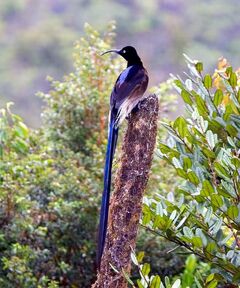| Black Sicklebill | |
|---|---|
 Male | |
| Information | |
| Range | New Guinea |
| Scientific Classification | |
| Kingdom | Animalia |
| Phylum | Chordata |
| Class | Aves |
| Order | Passeriformes |
| Family | Paradisaeidae |
| Genus | Epimachus |
| Species | Epimachus fastosus |
| Conservation Status | |
 Vulnerable | |
The Black sicklebill (Epimachus fastosus), is a species of large bird-of-paradise of midmountain forests of New Guinea.
The sicklebill's diet consists mainly of fruits and arthropods. The male of the species is polygamous and performs a horizontal courtship display with the pectoral plumes raised around its head.
In the wild, the bird has hybridised with the Arfak astrapia to create offspring that were once considered two distinct species, the Elliot's sicklebill (Epimachus ellioti) and the astrapian sicklebill (Astrapimachus astrapioides). Both species are generally viewed by most mainstream ornithologists as hybrids, but a minority of ornithologists believe ellioti may be a valid species.
Due to ongoing habitat loss, small population size, and hunting in some areas for food and its tail feathers, the black sicklebill is classified as Vulnerable on the IUCN Red List of Threatened Species. It is listed on Appendix II of CITES.
Description[]
The male has black plumage with iridescent green, blue and purple scale-like feathers, red irises, bright yellow mouth, long curved black bill, huge sabre-shaped tail and large erectile fan-like plumes on the sides of its breast. The female is smaller than the male, with reddish brown plumage, brown irises, and buff below. Reaching up to 110 cm in length, the male black sicklebill is the longest member of Paradisaeidae, though the curl-crested manucode has a larger body.
Subspecies[]
- Epimachus fastosus atratus
- Epimachus fastosus fastuosus
- Epimachus fastosus stresemanni
- Epimachus fastosus ultimus
